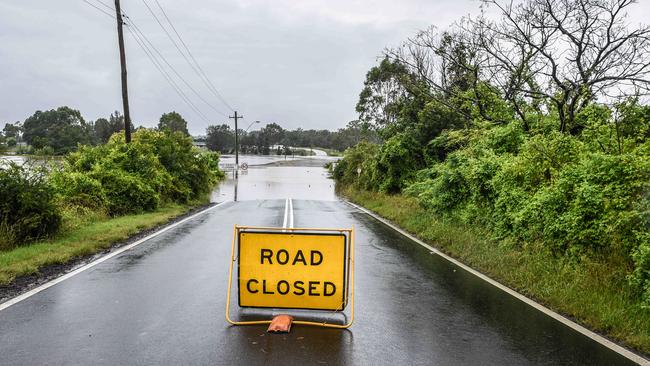Insurance claims from NSW floods may top $2bn bushfire payouts
Claims from the NSW floods could eclipse last year’s bushfire payouts, analysts have warned, as insurers take a sharemarket hit.

Insurance claims from the NSW and Queensland floods could eclipse last year’s $2bn bushfire payouts, analysts have warned.
As insurers ramp up their efforts to support customers affected by the record-breaking rains and flooding across the state’s east coast, claims have already started pouring in, with IAG on Monday morning telling the market it had received more than 2,100 claims as at 8pm on Sunday, covering mainly property damage.
Suncorp also updated the market, saying it had received 1300 claims as of Monday morning.
According to the Insurance Council of Australia, insurers have received more than 5000 claims in recent days, with many more expected in the coming weeks.
Insurers’ shares were hit as soon as the market opened, with Suncorp down 3 per cent, IAG falling 2.7 per cent and QBE dropping 2 per cent.
Based on the current level of claim lodgements and the ongoing impact of the event, IAG said it was “too early to accurately determine the net cost of the flooding and storms”.
But analysts are tipping payouts from the natural disaster will be substantial.
“It’s early days, but given the magnitude of the floods and the homes and personal property impacted, I wouldn’t be surprised to see these claims will exceed what was paid out for the bushfires,” Morningstar analyst Nathan Zaia told The Australian.
More than 38,000 claims were lodged as a result of the devastating 2020 bushfire season, worth an estimated $2.32bn, with the vast majority of the claims coming from residents in NSW.
“These floods will hit so many more properties, and personal property too. Flood events cause so much damage, not just flooding but damage to roofs and then leaks,” Mr Zaia said.
Floods rank as among the most costly events for insurers, given extensive damage to businesses and households that are impacted by rising waters. At the same time the number of traffic accidents also increases.
The last major flood payout for insurers was in February 2019, when torrential rains hit Townsville in far North Queensland and more than 30,000 claims triggered nearly $1.3bn in payouts, according to Insurance Council of Australia figures.
In February last year flooding across parts of NSW and south east Queensland triggered more than $900m in payouts across more than 100,000 claims.
“It looks very expensive,” Velocity Trade analyst Brett Le Mesurier said of the floods.
“If (claims) go over $1bn, the reinsurers will be making a major contribution to that.
“The reinsurers are there to pay for greater volatility. But it’s still a major event for the insurers. So this is going to push premiums up,” he said.
IAG, the nation’s largest general insurer, has activated its major response team and deployed extra staff to deal with the expected influx of claims, with property assessors on standby for when the floods dissipate.
“We know this is a very stressful time for those affected by the severe weather we are experiencing,” IAG chief executive Nick Hawkins said.
“Our immediate focus is on the safety of all the communities impacted by this heavy rain and flooding and we urge everyone to follow the directions of the emergency authorities.
“We now have additional resources in place to help our customers get back on their feet and we encourage customers to contact us to lodge their claim as soon as possible so we can organise immediate assistance.”
IAG houses well-known brands NRMA, CGU and Swann Insurance. As part of its 2021 catastrophe reinsurance program, it has a single event retention of $169m, with this reducing to $135m for a second event.
While the insurer has spread the risk through its quota share arrangements, UBS analysts warned that it has room for only one single large event before the end of the financial year.
“On the assumption that IAG has not incurred a gross event above $50m to date in the second half, their fiscal 2021 allowance has room for one large event.
“But if IAG were to have two or three maximum events in the second half, they would be looking at around 10 per cent fiscal 2021 earnings downside risk,” the analysts said in a note to clients.
Suncorp, meanwhile, has done “a lot of heavy lifting” in recent years, lifting its natural hazard allowance and buying additional reinsurance cover. The insurer has a per-event retention of $250m before reinsurance kicks in.
“On the assumption that Suncorp has not incurred a gross event above $50m to date in the second half, their fiscal 2021 allowance has room for one large event.
“Two maximum events could push Suncorp over their allowance and result in a 5 per cent fiscal 2021 earnings downside.”
Suncorp has a natural hazard allowance of $950m for the full year compared to IAG’s $975m ($658m post-quota share).
Ratings agency S&P Global Ratings said the severe flooding would lead to an influx of claims for the general insurers but that it would not hurt their credit quality.
“While the ultimate losses for individual insurers will vary -- depending on their exposure to the hardest hit areas, the declared number of events, and the structure of their reinsurance arrangements--we expect these to be manageable,” S&P said.





To join the conversation, please log in. Don't have an account? Register
Join the conversation, you are commenting as Logout